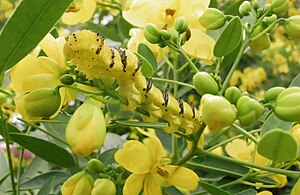
The Pieridae are a large family of butterflies with about 76 genera containing about 1,100 species, mostly from tropical Africa and tropical Asia with some varieties in the more northern regions of North America and Eurasia. Most pierid butterflies are white, yellow, or orange in coloration, often with black spots. The pigments that give the distinct coloring to these butterflies are derived from waste products in the body and are a characteristic of this family. The family was created by William John Swainson in 1820.
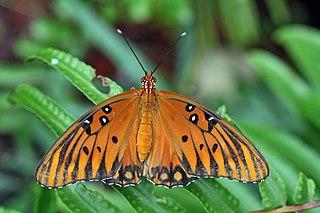
The Gulf fritillary or passion butterfly is a bright orange butterfly in the subfamily Heliconiinae of the family Nymphalidae. That subfamily was formerly set apart as a separate family, the Heliconiidae. The Heliconiinae are "longwing butterflies", which have long, narrow wings compared to other butterflies.

Anthocharis midea, the falcate orangetip, is a North American butterfly that was described in 1809 by Jacob Hübner. It belongs to the family Pieridae, which is the white and sulphurs. These butterflies are mostly seen in the eastern United States, and in Texas and Oklahoma. They eat the nectar of violets and mustards. They tend to live in open, wet woods along waterways, in open swamps, and less often in dry woods and ridgetops. This species is a true springtime butterfly, being on the wing from April to May.

Coliadinae, the sulphurs or yellows, are a subfamily of butterflies with about 300 described species.

Colias eurytheme, the orange sulphur, also known as the alfalfa butterfly and in its larval stage as the alfalfa caterpillar, is a butterfly of the family Pieridae, where it belongs to the lowland group of "clouded yellows and sulphurs" subfamily Coliadinae. It is found throughout North America from southern Canada to Mexico.

Senna hebecarpa, with the common names American senna and wild senna, is a species of legume native to eastern North America.

Colias philodice, the common sulphur or clouded sulphur, is a North American butterfly in the family Pieridae, subfamily Coliadinae.

Eurema nicippe, the sleepy orange, is a North American butterfly in the family Pieridae. It is also found in the West Indies, Costa Rica and Belize.

Phoebis, or sulphurs, is a genus of butterflies, belonging to the subfamily Coliadinae of the "whites" or family Pieridae. They are native to the Americas.

Senna marilandica, commonly known as Maryland senna, Maryland wild senna, and wild senna, is a perennial flowering plant in the pea family (Fabaceae) native to the United States. It blooms in the summer with yellow flowers, followed by long seed pods, and can grow up to 2 m (6 ft) tall. It prefers average to wet soil.

Kricogonia lyside, the lyside sulphur or guayacan sulphur, is a North American, Caribbean, and South American butterfly in the family Pieridae.
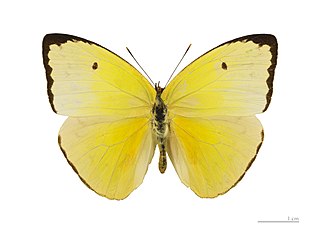
Aphrissa statira, the statira sulphur, is a species of Lepidoptera in the family Pieridae. The species is a medium-sized yellow butterfly, with females more pale than males. They are found from southern regions of Florida and Texas through southern Brazil and northern Argentina. The caterpillars feed on the leaves of several local host plants, while adults prefer to feed on the nectar of red or orange colored flowers. The species is most noted for their dramatic migrations in the tropical areas of the Americas. They have been the subject of many studies about how butterflies navigate and orient during migration.
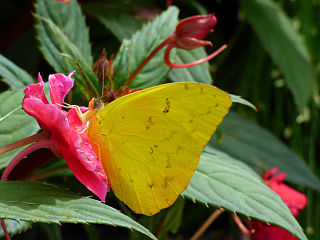
Phoebis philea, the orange-barred sulphur, is a species of butterfly found in the Americas including the Caribbean.

Rhabdodryas is a genus of butterflies in the family Pieridae. The only species is the straight-line sulphur.
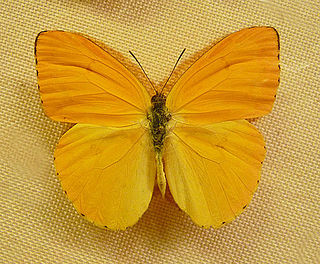
Phoebis argante, the apricot sulphur or Argante giant sulphur, is a butterfly in the family Pieridae.
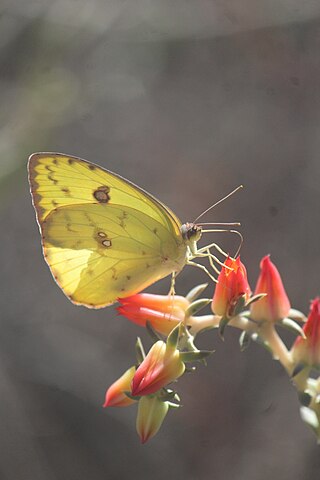
Phoebis marcellina is a species of butterfly found in the Western Hemisphere between roughly the latitudes of 34° N and 30° S. Previously considered a subspecies of Phoebis sennae, the marcellina sulphur was elevated to full species status in 2020 after "recent pierid DNA barcode studies across the Neotropics" found more species diversity than had been previously recognized.





